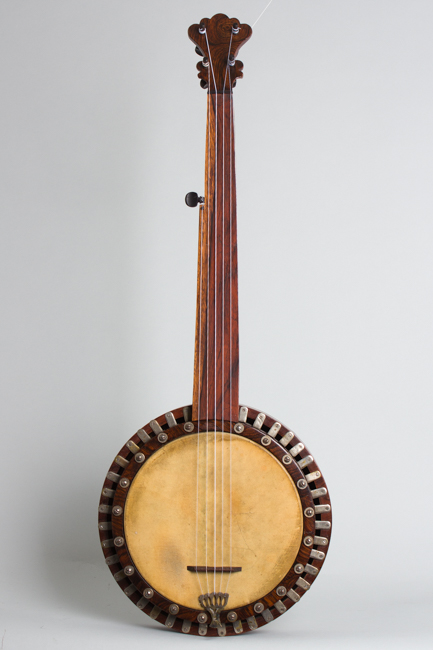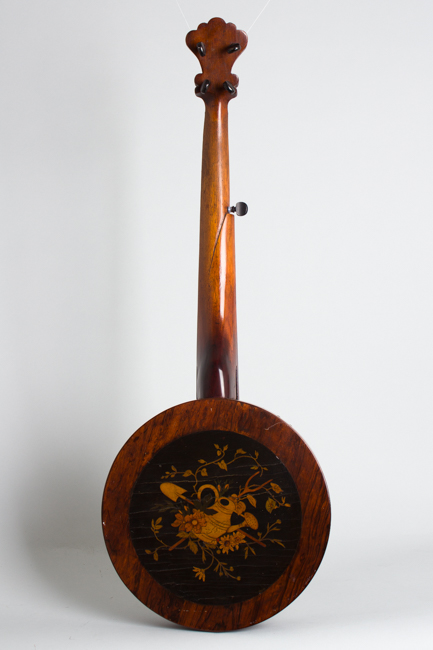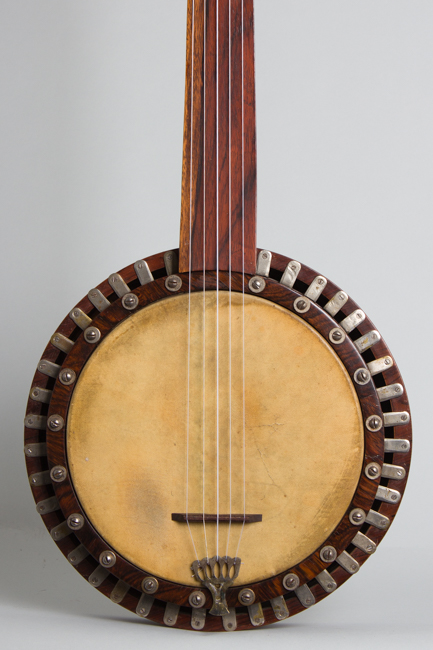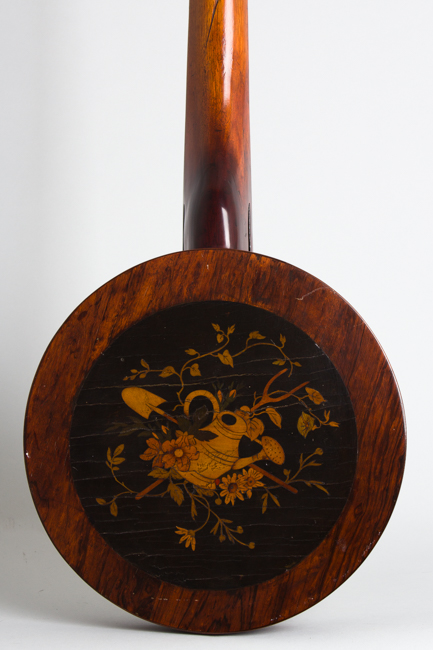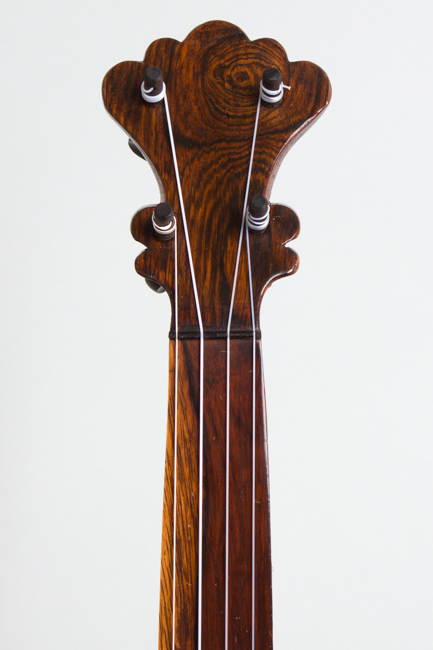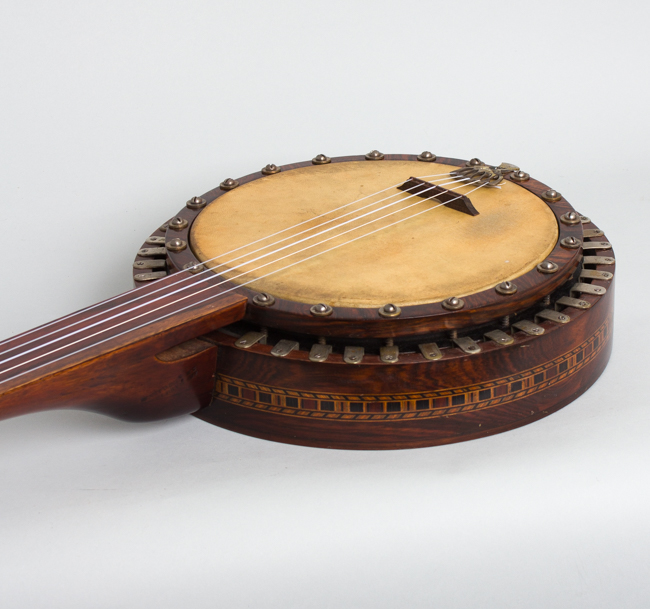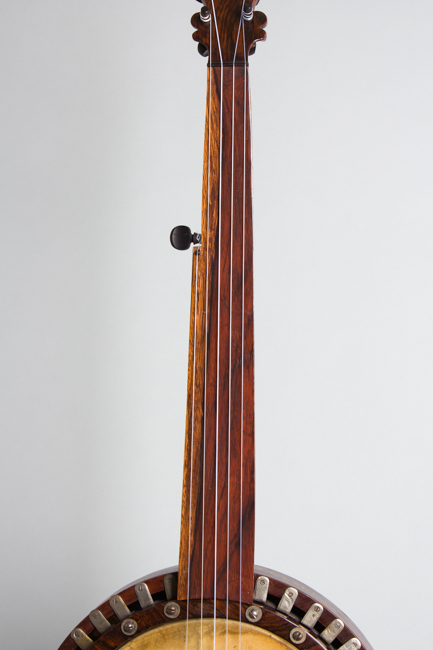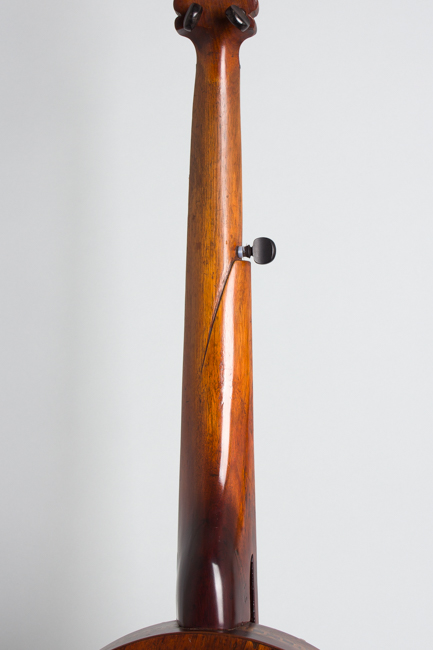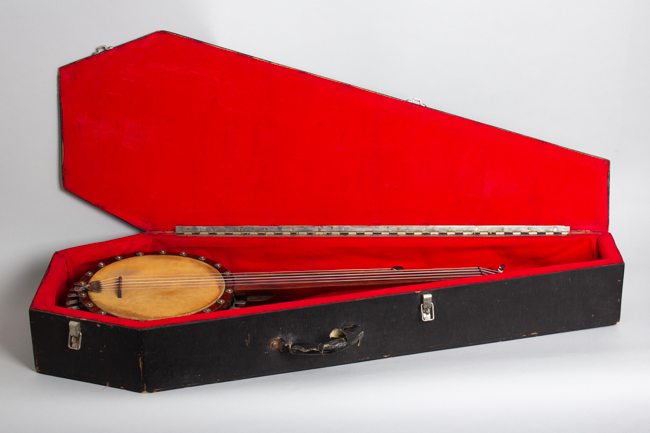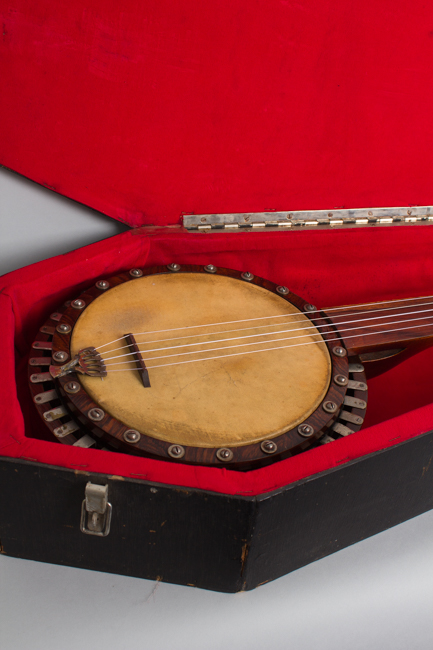Henry C. Dobson 5 String Fretless Banjo , c. 1870
This item is currently on hold.
Item # 12687
Prices subject to change without notice.
Henry C. Dobson 5 String Fretless Banjo, c. 1870, made in New York City, natural varnish finish, laminated rim and resonator with rosewood veneer; mahogany neck, black coffin case.
This banjo is a fantastic piece of history, a fully playable survivor of the just-post Civil War era built right here in New York. It carries the stamp of Henry C. Dobson with a patent date of July 16 1867 on the upper side of the heel. This unusual style banjo is unique to its time; when this instrument was built, banjo evolution had progressed only in fits and starts beyond the tacked-head Minstrel banjos of the 1840's and 50's. Compared to those, this is an incredibly futuristic design with some features that would not become common until the 1920s.
Unlike the nearly ubiquitous open back 19th century banjos this is a resonated, top tension instrument. The overall design is not unlike a late 1920's Vegavox: the rim is fitted into a closed-back resonator and 20 screws are used to tension a wooden hoop from the top. The New York banjo world was rife with innovation in this period, and "inspiration" was sometimes taken despite nominal patent protection. Setting the rim into a resonator from above was pioneered by New Yorker George Teed, who was issued a descriptive patent in 1862. With further refinements by Brooklyn native Alfred Cammeyer the internal rim/resonator design became the basis for the English Zither banjo later in the 19th century. Several other 1860s patents also covered variations on this idea.
Henry C. Dobson was the oldest of five Dobson brothers all involved in the banjo trade from the 1860s-1890s. Like many he started as a player, then teacher and progressing to designer and builder as was often the case in that age of innovation. This instrument is built closely to his patent of 1867, as marked on the heel. The design continued to be developed over the next decade but this is a fancier-than-many variation on the most familiar version of the closed-back Dobson.
The resonator is laminated with figured rosewood with a circular section of wood veneer artwork set into the back depicting a gardening motif with a flowerpot, shovel and leaf fronds. The side of the resonator has an inset wood marquetry strip as well. The wooden rim and hoop are set in to the closed-back resonator via bent metal pieces screwed to the upper edge. The wooden hoop is rosewood laminated on the top surface as well.
The mahogany neck is carved fairly shallow in the lower positions with a very thin rosewood fretless fingerboard. The elaborate fluted headstock with ebony violin pegs is typical of Dobson practice. This futuristic Dobson design disappeared in the later 19th century as Stewart and then Fairbanks & Cole perfected their "elevated" openback banjos that remain the standard today but this one survives as a fabulous link back to the wild and wooly banjo world of the 1860-70s.
Overall length is 35 1/2 in. (90.2 cm.), 9 3/4 in. (24.8 cm.) diameter head, and 3 3/4 in. (9.5 cm.) in depth, measured at side of rim. Scale length is 25 1/2 in. (648 mm.). Width of nut is 1 1/4 in. (32 mm.).
While it shows numerous signs of age, for being at least 150 years old this is a very well-preserved instrument with a mostly original patina. The very thin varnish finish is largely original with some checking and scratching overall and numerous dings, dents and scrapes. The resonator sides appear to have been polished out, likely when the bottom edge was reglued in spots long ago. The back may have a light overcoat as well; while there is some noticeable splitting to the veneer artwork on the back it remains complete. The finish on the neck is worn down to the wood in the lower positions. The fingerboard is in better shape than many without noticeable finger wear.
There is one major repair, an old crack through the heel which is solidly sealed with some overfinish and extra shading added to the heel section only. The Dobson stamp is partially finished over but still visible. Apart from this the instrument is structurally excellent. The somewhat fragile wooden hoop is in excellent shape with none of the common cracks and remains completely solid.
The hardware appears all original. The top-tension and resonator mounting screws are intact and complete. The elaborate and delicate tailpiece is original showing an old repair that appears solid on the tail end. The wooden violin-style tuning pegs appear to be an original matched set or at least period correct and function well. The bridge is nondescript but appears to be older if not period. The skin head is quite old; it has some stress lines but appears solid and holds tension.
This banjo is fully playable and sounds good with NylGut strings, with a deep if not particularly loud sound. This instrument offers a true trip back to 19th century New York. While we can't exactly recommend taking it out to entertain the rowdy crowd in an 1870's style saloon, this is a completely usable banjo for the dedicated historical player as well as a superb piece of New York banjo history. It comes in an older coffin case that appears heavily reworked more recently. Overall Very Good + Condition.
This banjo is a fantastic piece of history, a fully playable survivor of the just-post Civil War era built right here in New York. It carries the stamp of Henry C. Dobson with a patent date of July 16 1867 on the upper side of the heel. This unusual style banjo is unique to its time; when this instrument was built, banjo evolution had progressed only in fits and starts beyond the tacked-head Minstrel banjos of the 1840's and 50's. Compared to those, this is an incredibly futuristic design with some features that would not become common until the 1920s.
Unlike the nearly ubiquitous open back 19th century banjos this is a resonated, top tension instrument. The overall design is not unlike a late 1920's Vegavox: the rim is fitted into a closed-back resonator and 20 screws are used to tension a wooden hoop from the top. The New York banjo world was rife with innovation in this period, and "inspiration" was sometimes taken despite nominal patent protection. Setting the rim into a resonator from above was pioneered by New Yorker George Teed, who was issued a descriptive patent in 1862. With further refinements by Brooklyn native Alfred Cammeyer the internal rim/resonator design became the basis for the English Zither banjo later in the 19th century. Several other 1860s patents also covered variations on this idea.
Henry C. Dobson was the oldest of five Dobson brothers all involved in the banjo trade from the 1860s-1890s. Like many he started as a player, then teacher and progressing to designer and builder as was often the case in that age of innovation. This instrument is built closely to his patent of 1867, as marked on the heel. The design continued to be developed over the next decade but this is a fancier-than-many variation on the most familiar version of the closed-back Dobson.
The resonator is laminated with figured rosewood with a circular section of wood veneer artwork set into the back depicting a gardening motif with a flowerpot, shovel and leaf fronds. The side of the resonator has an inset wood marquetry strip as well. The wooden rim and hoop are set in to the closed-back resonator via bent metal pieces screwed to the upper edge. The wooden hoop is rosewood laminated on the top surface as well.
The mahogany neck is carved fairly shallow in the lower positions with a very thin rosewood fretless fingerboard. The elaborate fluted headstock with ebony violin pegs is typical of Dobson practice. This futuristic Dobson design disappeared in the later 19th century as Stewart and then Fairbanks & Cole perfected their "elevated" openback banjos that remain the standard today but this one survives as a fabulous link back to the wild and wooly banjo world of the 1860-70s.
Overall length is 35 1/2 in. (90.2 cm.), 9 3/4 in. (24.8 cm.) diameter head, and 3 3/4 in. (9.5 cm.) in depth, measured at side of rim. Scale length is 25 1/2 in. (648 mm.). Width of nut is 1 1/4 in. (32 mm.).
While it shows numerous signs of age, for being at least 150 years old this is a very well-preserved instrument with a mostly original patina. The very thin varnish finish is largely original with some checking and scratching overall and numerous dings, dents and scrapes. The resonator sides appear to have been polished out, likely when the bottom edge was reglued in spots long ago. The back may have a light overcoat as well; while there is some noticeable splitting to the veneer artwork on the back it remains complete. The finish on the neck is worn down to the wood in the lower positions. The fingerboard is in better shape than many without noticeable finger wear.
There is one major repair, an old crack through the heel which is solidly sealed with some overfinish and extra shading added to the heel section only. The Dobson stamp is partially finished over but still visible. Apart from this the instrument is structurally excellent. The somewhat fragile wooden hoop is in excellent shape with none of the common cracks and remains completely solid.
The hardware appears all original. The top-tension and resonator mounting screws are intact and complete. The elaborate and delicate tailpiece is original showing an old repair that appears solid on the tail end. The wooden violin-style tuning pegs appear to be an original matched set or at least period correct and function well. The bridge is nondescript but appears to be older if not period. The skin head is quite old; it has some stress lines but appears solid and holds tension.
This banjo is fully playable and sounds good with NylGut strings, with a deep if not particularly loud sound. This instrument offers a true trip back to 19th century New York. While we can't exactly recommend taking it out to entertain the rowdy crowd in an 1870's style saloon, this is a completely usable banjo for the dedicated historical player as well as a superb piece of New York banjo history. It comes in an older coffin case that appears heavily reworked more recently. Overall Very Good + Condition.
